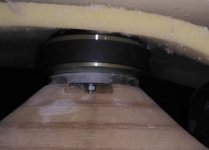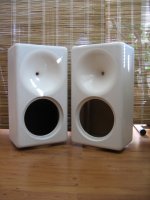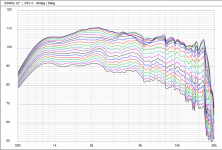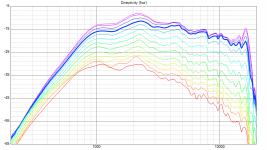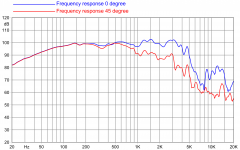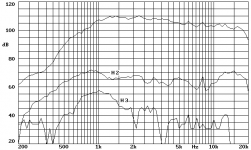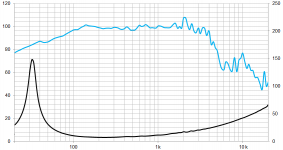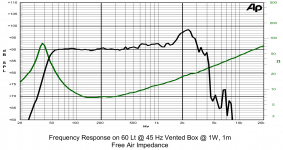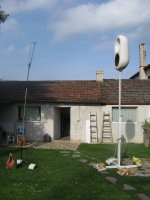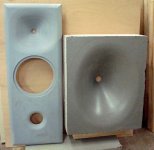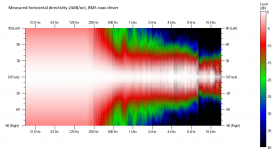A diy project built around one of Marcel's (mabat) STH (now ATH4) waveguides.
Drivers: B&C DE250 + SICA 12SR3PL.
These look like excellent designs. Add a foam plug to the waveguide and you have a Summa (circa 2002) - same excellent polar response. Well more like the Abbey since the woofer is 12" not 15". I don't like the way the compression driver is mounted however.
Want to know what waveguide is "optimum" you can see it here. I can't speak to the details of the waveguide since I don't have a detailed drawing of it, but I would not have made it approach square and I suspect the small aberrations around 8 kHz are due to this change, but it could be a non precise throat.
Last edited:
Greetings to all!
I would like to ask an opinion regarding the woofer of this two-way project. I found the BEYMA 15p80FeN or 15p80Nd and I saw that theoretically they should be valid candidates, someone describes them with a precise and powerful sound ... unfortunately I have no experience on them, I would ask if someone used them to report their experience , in particular 15p80feN. Thank you in advance, renewing greetings.
Mleod
The peaks at 2kHz may be hard to tame unless you cross fairly low. In a two-way system, how the woofer handles these breakups is all important.
There may not be an "ultimate", but for any desired situation and given constraints, there is always an optimum. Give me these criteria and I can design a device that is optimum. Now, of course, the more restrictive the criteria, the more compromises must be accepted in the optimum. It almost always comes down to size. People just don;t want to accept the size of device that can be required to go lower in frequency and the tradeoff with size is always a substantial one.
As someone who's come up from small speakers recently I can't tell you how true this is. I slapped some cheap (but semi ok) 10" in an old 100l cab and with a mini dsp they astonish people. It's that cliche, there's no replacement for displacement.
Was going to ask why you chose the ph-3520 over the ph-3220 but never mind 🙂
You can still ask 😉 For one the 3520 is bigger, the 3220 is 100 deg, I'd like it to be a bit less. It's also double the price. I might consider PH-4220 though. It's also a bit wide at 90 deg though.
What's wrong with it?... I don't like the way the compression driver is mounted however.
Attachments
I don't know, I have measured a very similar behaviour on my old (round) 12" OSWGs - also using DE250, different pieces. I would almost believe it is the driver because the waveguides were done so differently.... but I would not have made it approach square and I suspect the small aberrations around 8 kHz are due to this change, but it could be a non precise throat.
Or what do you mean by "non precise throat"?
Attachments
Last edited:
Greetings to all!
I would like to ask an opinion regarding the woofer of this two-way project. I found the BEYMA 15p80FeN or 15p80Nd and I saw that theoretically they should be valid candidates, someone describes them with a precise and powerful sound ... unfortunately I have no experience on them, I would ask if someone used them to report their experience , in particular15p80feN. Thank you in advance, renewing greetings.
Mleod
From left to right:
1. Sica 12SR3PL, used for the 2 way with mabat's waveguide crossed at 1100Hz.
2. Beyma 15P80Fe/N.
Conclusion: perfect for a 2 way with XO below 1000Hz.
3. Tip: Beyma CP380/M, top class 1" driver.
4. For comparison: FaitalPRO 15PR400, a favorite among many contributors to this thread.
Attachments
Last edited:
What's wrong with it?
This looks better than the other photo, but it still concerns me. Is the waveguide shape carried through the mounting plate?
I don't know, I have measured a very similar behaviour on my old (round) 12" OSWGs - also using DE250, different pieces. I would almost believe it is the driver because the waveguides were done so differently.
Or what do you mean by "non precise throat"?
Even a few mm of error at the interface between the driver and the waveguide will cause this kind of problem. I would need to see precise details of this juncture and that it is maintained in production.
I did not see this level of aberration in my DE250's, so I doubt that it is the driver. It really looks like a mounting issue to me.
There may not be an "ultimate", but for any desired situation and given constraints, there is always an optimum. Give me these criteria and I can design a device that is optimum. Now, of course, the more restrictive the criteria, the more compromises must be accepted in the optimum. It almost always comes down to size. People just don;t want to accept the size of device that can be required to go lower in frequency and the tradeoff with size is always a substantial one.
Hi Earl, it certainly seems to be the case. My bass cabs are already the size of fridges, so I am happy to accept a large constant directivity waveguide that crosses low (e.g. 600 Hz). Trying to find a good commercial one, better than the JBL 2384 as mentioned in post 2071, but none seem to exist and diy seems out of reach, for me anyways. Maybe the large 2 way (i.e. 15" woofer(s) with XO below 1 kHz to a large CD waveguide is a thing of the past...
Of course it is. It is milled as a one piece - the plate is glued to the WG body. In fact it should be quite precise all the way through (CNC).This looks better than the other photo, but it still concerns me. Is the waveguide shape carried through the mounting plate?
I did not see this level of aberration in my DE250's, so I doubt that it is the driver. It really looks like a mounting issue to me.
Early production DE250s (all white label) are the most consistent wrt quality.
Post ca. 2012 production DE250s (black B&C logo/white label) are not as good.
I sold mine (2014 production) for this reason. These were no match for the Beyma CP380/Ms
Last edited:
Thanks Ro808!
The evidences that you have proposed to me are very clear, however the 15p80FeN seems to have an almost double efficiency compared to the 15PR400, I don't know exactly what this involves in the sound, I suppose a more speed and greater damping for which I would be oriented towards the Beyma .... what do you think about it ...
Thanks, greetings to all.
Mleod
The evidences that you have proposed to me are very clear, however the 15p80FeN seems to have an almost double efficiency compared to the 15PR400, I don't know exactly what this involves in the sound, I suppose a more speed and greater damping for which I would be oriented towards the Beyma .... what do you think about it ...
Thanks, greetings to all.
Mleod
Some more pictures I just must share... 🙂
(18" woofer + 20" OSWG on the left.)
Very nice! Any more info?
Mitch
I had ideas about making a large waveguide and an 18" woofer (required for DI matching at the lower x-over), but the market for something that big would have been negligible. Premium performance is just not a real market want. Compromise, compromise, compromise, as long as it is small, looks "cool" and doesn't cost much. Not very appealing for people like us.
I had ideas about making a large waveguide and an 18" woofer (required for DI matching at the lower x-over), but the market for something that big would have been negligible. Premium performance is just not a real market want. Compromise, compromise, compromise, as long as it is small, looks "cool" and doesn't cost much. Not very appealing for people like us.
Some more pictures I just must share... 🙂
(18" woofer + 20" OSWG on the left.)
Why always ported? That just seems like a old philosophy to me. Multiple subs negates any need for ports and their compromised low end performance (uncontrolled cone motion below port tuning.) Best just use closed boxes and Sub EQ.
Even a few mm of error at the interface between the driver and the waveguide will cause this kind of problem. I would need to see precise details of this juncture and that it is maintained in production.
I did not see this level of aberration in my DE250's, so I doubt that it is the driver. It really looks like a mounting issue to me.
Do you see interface problem above 8KHz here?
Attachments
Early production DE250s (all white label) are the most consistent wrt quality.
Post ca. 2012 production DE250s (black B&C logo/white label) are not as good.
I sold mine (2014 production) for this reason. These were no match for the Beyma CP380/Ms
I used de250's from their initial release. Then in 2012 they did change it (and forgot to tell me about it!) But I would not say that they were worse, just different.
To me compression drivers are all pretty much the same. It is the waveguide and crossover that makes for 90% of the sound quality.
I once did identical base designs using DE250 and Tads - a 10:1 price differential. In listening tests of >20 people, the results were inconclusive in that there was no statistical difference between the two.
Sue that last 10% is worth going after, but it's not a big thing - drivers are drivers and I can make any of them work just fine. All this talk about how much better X sounds than Y is simply "fashion."
Do you see interface problem above 8KHz here?
Not enough detail, but yes, since the problems are not diffraction (lines are vertical not curved) my first suspicion would be a poor waveguide somewhere along its length.
If that plot is normalized then all bets are off since normalization ruins the picture.
Also, since it is a coax, that problem could also be due to the transition between the two. This is precisely why I never like coaxes. This always occurs.
Last edited:
- Home
- Loudspeakers
- Multi-Way
- Is it possible to cover the whole spectrum, high SPL, low distortion with a 2-way?
